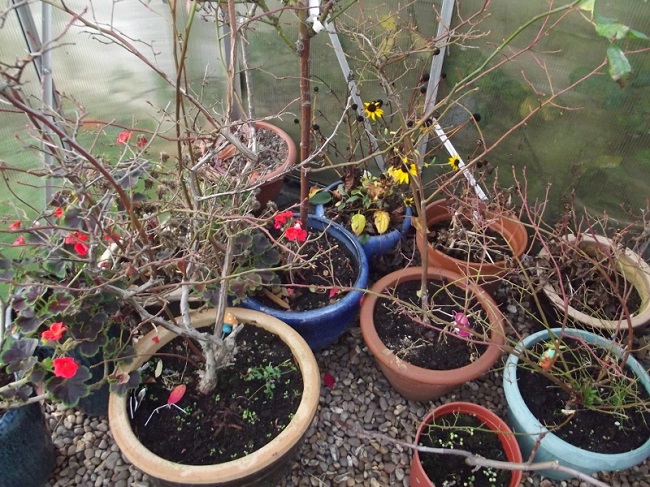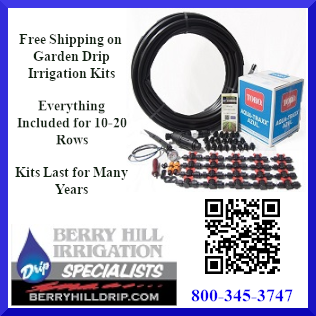The last two years, color in my yard is almost entirely due to my overwintered containers. While I love to have flowers blooming throughout my yard, there is only so much time. Luckily, with a greenhouse, I’m still able to have beautiful containers each spring without doing much work. If you like short cuts; overwintering is one of the best time savers you’ll find.

The objective in overwintering plants is to keep the plant in a dormant stage so it will return in the spring. To do this, the plant will need some warmth, and some water. Depending on the plant, light and nutrients may also be necessary. If the plant continues to grow, you will want to feed and water it more often than those that are dormant.
Fall is an excellent time to start planning your spring containers. If your containers aren’t currently planted with perennials, fall is a great time to stock up. Many nurseries liquidate their tender perennials at the end of the season at deep discounts and many plants sold as annuals are tender perennials and will survive the winter as long as their roots do not freeze. Some self seeding annuals also make good candidates. While they do not technically overwinter, they may reseed themselves giving you a jump start on germination. The most reliable method, however, is focusing on perennials.
Start to prepare your containers before your local frost date approaches. As the days grow shorter, cut back on fertilizer and water and as the growth slows, cut the plant back. In most cases you will cut off a significant amount of growth but leave some foliage to produce energy to store in the roots. Allow a few weeks for the plant to recover before relocating it to the greenhouse.
It’s a good idea to spend some time preparing your greenhouse as well. This is a good time to thoroughly clean the greenhouse by removing all plant material and thoroughly washing everything in the greenhouse. If the covering is made of a non-reactive material, it is a good idea to use a bleach solution to kill any unwanted pathogens. Remove any dead plant material from plants going back into the greenhouse. (Do not use bleach on polycarbonate products as it creates a dangerous chemical reaction.) As much as it may be tempting to try to rescue unhealthy plants, resist the temptation and allow only the healthiest plants into the greenhouse.
Whether you plan to add heat or not, it is important to consider the type of greenhouse covering you currently have. If the covering is made of a single wall material, it is not insulated. If the temperature falls much below freezing, a greenhouse without insulation will not provide much protection other than keeping frost off plants. If recovering your greenhouse is not an option, you may want to consider adding a layer of bubble wrap on the inside of the greenhouse to increase the heat retention. Just be sure to keep vents free so there is some air movement in the structure. Plants need to have fresh air to survive, so there is no need to try to make the structure airtight. If you want to heat your greenhouse, but are on a tight budget, read this article for information on how to heat a greenhouse without using electricity.
Once your greenhouse is ready, it’s time to start planning where things will go. If your greenhouse does not have benches, you may want to make some temporary stands to keep the containers off the ground. Many decorative containers are very heavy, so keep that in mind. Elevating the containers will help keep them off the cooler ground but it is not absolutely necessary. If you have the room, using 5 gallon buckets filled with water as a stand you will get a double benefit. The buckets (painted black on the side with the most sun exposure) will collect heat from the sun during the day and the slightly warmer temperate will help keep the containers from freezing at night if you do not have heat in your greenhouse. Additionally, wrapping the containers with a layer of bubble wrap will also add insulation if your greenhouse does not have heat and freezing temperatures are possible.
When you are ready to move the container into the greenhouse, one of the easiest ways to move heavy or large pots is with a Pot Lifter. The Pot Lifter will hold about 250 pounds and fastens easily around containers of all sizes and two people can easily move large containers, making overwintering much easier. It is also possible to repot plants into smaller containers; however, in a cool greenhouse larger containers are easier to keep over because they hold more moisture and more heat.
Managing humidity in a winter greenhouse should not be overlooked. While it’s important to avoid excess moisture, some moisture is required to keep plants alive and to keep containers from freezing. Dry containers are more at risk in cold temperate than those with some moisture. Watering in a cool greenhouse in the winter can be tricky. Checking plants every few weeks with a moisture meter will help you determine when to water. Adding a soil amendment like coir or peat moss to hold water will also help maintain the proper balance. If you did not do this at the time of planting, Rain Gel-Jector is a good option. This moisture retaining product comes in a calking tube that is inserted into the soil and injected. The space created by the gel creates spaces for roots to grow and keeps moisture where the plant will use it most. This will also reduce watering requirements making the process faster and easier to control.
Monitoring the high and low temperatures in a winter greenhouse is especially necessary if you do not have heat. There are many min/max thermometers available ranging from simple manual models to sophisticated remote weather stations but a thermometer with a remote sensor is ideal, allowing easy monitoring from indoors. Some thermometers also have hygrometers which measure the humidity which is helpful. At a minimum, it is critical to know how cold and how warm the greenhouse is getting so you can determine if more heat or more cooling is needed.
If you find your greenhouse is too cool at night, there are a few things you can do to add or maintain heat. If electricity is available in the greenhouse, there are several options. The least expensive and perhaps most available is a light bulb or string of Christmas lights. In many cases, this small amount of heat at night is all that is needed to maintain the temperature. In most cases, even if the air temperature is below freezing, the soil will be a few degrees warmer and depending on the material of the container, the container itself may also store heat. Seedling heat mats placed under particularly fragile plants will help as well. A variety of heaters are available if more heat is needed and for overwintering, generally a small space heater will do the trick in most areas. The heater must be rated for outdoor use and protected from moisture and water. Some heaters have a thermostat allowing you to set and exact temperature, however, most electric heaters only allow you to set a range of heat. Some heaters have only low, medium, and high settings and will not turn off automatically once a temperature range is achieved and if you are using a heater without a thermostat or rheostat, you will need to have means of venting excesses heat from the greenhouse with an exhaust fan.
Using gas heaters is more involved than electric because gas heaters generate moisture and require oxygen to combust. The moisture in a cool greenhouse will result in extremely high humidity if it is not vented out of the greenhouse before the condensation occurs. Cool fresh air is needed to operate the unit, so a constant exchange of air is needed to maintain the proper balance. Gas heat is effective and works well for heating a greenhouse but is perhaps more involved for overwintering than needed unless it is being used in very cold areas.
If you do not have a way to heat your greenhouse, there are low-tech methods that work as well. Passive solar collection works well with the 5-gallon buckets as mentioned above but will also work with milk or other containers filled with water. A collection of containers will create thermal mass which will help maintain heat. Read this article for more information on passive solar heating in a greenhouse. A frost protection bag is another option. The fabric, designed to keep frost at bay, may add the extra protection needed to keep roots from freezing.
When spring arrives, you will have advanced warning as your greenhouse will show signs of awakening long before the outside world. Once there is evidence of growth, fertilize with high quality slow-release nutrients and enjoy the early signs of spring. Worm castings are an excellent choice for over wintered containers. The castings are easy to add to the top layer of soil and provide hormones which stimulate growth. Start checking water levels more frequently as the plant grows. As the weather warms, it is a good idea to open the greenhouse doors and vents allowing the plants to acclimate to the new weather. It is also a good idea to move plants to a protected location for a few days before placing tender new growth in direct sunlight.
Eventually as the plants outgrow the containers, you will need to do some transplanting, but the time savings is substantial. It’s amazing though how much time and money you can save when you over winter. While it may be hard to justify a plant purchase for something that will last only one season, it’s much easier to create the garden or containers you love knowing there is a good chance they will be back year after year.
Michelle Moore is the General Manager of the Greenhouse Catalog where she has worked with greenhouses for over 20 years. Michelle writes and lectures about greenhouse gardening as an Oregon State University Master Gardener and member of Garden Writers Association. Michelle is a Fulbright Scholar and earned an International MBA from Thunderbird, School of Global Management. Michelle and her husband live in Oregon, but they enjoy hints of summer all year in their greenhouse. You can visit their website at GreenhouseCatalog.com.
Related Articles & Free Email Newsletter Sign Up
4 Things You Need to Know Before Building a Greenhouse
Active Solar Heating for Greenhouses
The 4 Best Grow Lights for Greenhouses




Comment here